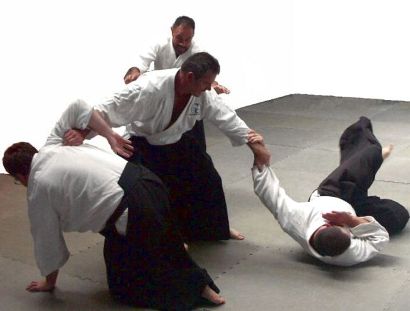Training
Information about our Aikido Training
Aikido translates to the way of harmonious spirit.
O Sensei has been quoted as saying
"I want considerate people to listen to the voice of Aikido.
It is not for correcting others; it is for correcting your own mind.
This is Aikido. This is the mission of Aikido and should be your mission."
Aikido involves both physical and mental training
Aikido training involves learning the physical techniques, cultivating awareness of ones opponent and the self-discipline required to commit to a long term learning process.
Physical conditioning develops through practice focused on moving the whole-body in a coordinated way. This assists in the development of flexibility and endurance.
Training focuses on re-directing the force of the attacker rather than using strength to overcome them.
The mental aspect of aikido training consists of learning controlled relaxation. This allows us to meet an attacker with confidence and a sense of calm to execute the techniques of aikido without hesitation.
A fundamental characteristic of aikido is concern for the well-being of others. Students learn to protect themselves rather than to harm another person.
Ukemi
Ukemi is the art of responding correctly and safely to aikido's defensive techniques. This is one of the first skills students are introduced to and will be enhanced over many years of training to allow safe escape from the technique regardless of the which way it directs you. This skill is necessary because aikido consists mostly of either projecting the attacker away or directing them to the floor in a controlled manner. Typically requirements in this area are modified for age and physical limitations.
Partnership
Aikido techniques are typically taught by partnering two students together following a demonstration by an instructor. In these pairings, one student will attack and the other will utilize a prearranged form as a defence. While aikido training does involve some solo drills, this collaboration among students is the primary way that aikido is taught and learned.
Defending against Holds
If someone is holding you or pulling you, Aikido has a techniques to use their energy and grip to your advantage. The principle of non-resistance means that rather than opposing the hold you work with it to take the other persons balance and redirect their energy
Defending against Strikes
Punches and strikes to the head and body can be dealt with using a range of aikido techniques. These typically involve a 'body shift' to avoid the attack combined with controlling the attacker to prevent further attacks
Throwing Techniques (projections)
Aikido has many throws, that are useful to control attacker. In practice in the dojo the attacker will typically take ukemi by rolling out of the technique and away from the defender. This option is only available to someone who has appropriate training to fall and roll safely and comfortably.
Pinning Techniques (immobilisations)
Aikido has a range of techniques that end with a pin. these are designed to immobilise an attacker rather than have them roll away. They involve applying locks to the joints which are difficult to break away from however, while training in the dojo, we ensure safety by having the attacker 'tap out' at the point the pin becomes uncomfortable.
Weapon Disarming
You will learn how to disarm attackers using knives, swords and wooden staves. In class wooden alternatives to knives and swords are used for safety.
Weapon Techniques
As the hand techniques of aikido are derived from sword and staff you will learn techniques with the bokken (wooden sword) and jo (wooden staff), along with kata (patterns), and paired sequences.These develop perception of distance, harmonisation with a partner and add an intensity to practice
Multiple Attackers

Kokyu and randori are activities where you learn to deal with multiple attackers. These teach calmness under pressure and strategy
Self Discipline/Perserverance
Self-discipline and perseverance are the key to success in any field. Aikido is the perfect platform to develop these skills, and rewards hard work and persistence.
Improved Balance and Posture
As your training progresses, you will become fitter and more flexible, with better balance and coordination.
Japanese Etiquette
You will develop an insight into the Japanese etiquette and tradition that accompanies budo (Japanese martial arts).
